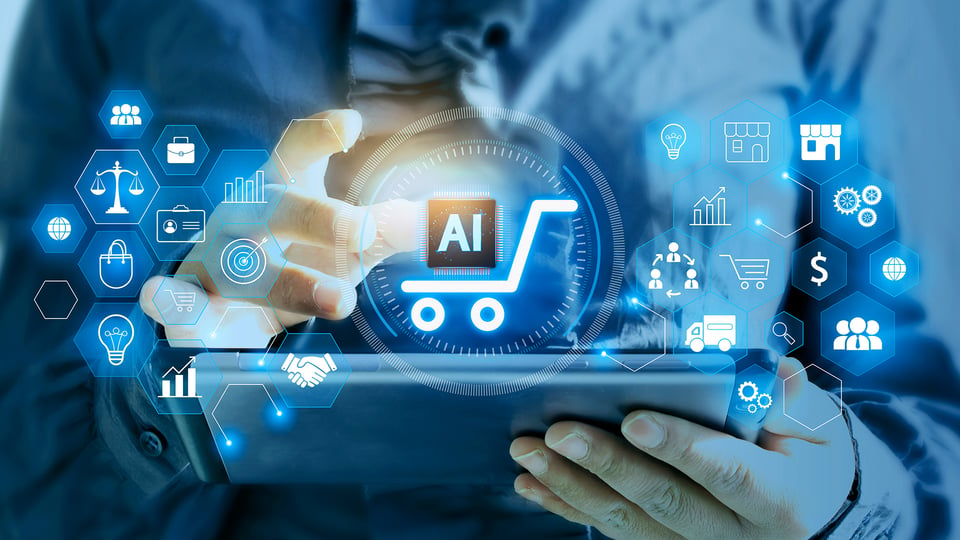Artificial intelligence is transforming the way we shop, revolutionizing ecommerce by personalizing experiences, enhancing customer service, and optimizing inventory management. As AI-driven innovation reshapes the industry—from tailored recommendations to immersive AR shopping—its impact is undeniable.
This transformation will be a key topic at SXSW 2025, a leading tech and innovation festival in Austin, showcasing cutting-edge advancements in AI, startups, ecommerce, entertainment, and emerging digital trends through panels, networking, and immersive brand activations. While SXSW is widely known for its influence in music, TV, and film, it has also become a major hub for discussions on technology and the future of digital commerce.
At this year’s event, industry leaders will explore AI’s role in redefining ecommerce, from hyperpersonalization to predictive analytics. The future of online retail lies in harnessing AI not just to enhance the shopping experience, but to streamline operations and drive marketplace success. At ChannelEngine, we’re committed to helping brands navigate this AI-powered transformation.
AI in ecommerce marketplace management
From a seller's perspective, AI isn’t just a tool for personalization but a game-changer for operational efficiency and customer engagement. By utilizing AI-driven tools, marketplace sellers can optimize inventory management, enhance customer service through chatbots, and gain actionable insights from data analytics.
In this article, we’ll explore how AI is shaping the future of ecommerce, from enhancing personalization and automation to optimizing supply chains and customer interactions. We’ll also look at the latest innovations and how businesses like yours can leverage AI to stay ahead in an evolving digital marketplace.
1. Purchase recommendations
Algorithms powered by AI in ecommerce analyze user behavior and historical data to provide customized product recommendations. These recommendations improve the user experience and increase the chances of conversions. By recognizing a shopper's preferences, AI can curate a selection of products that match their tastes, resulting in increased customer satisfaction and engagement.
Amazon is the most well-known ecommerce marketplace for product recommendations. In fact, according to some reports, 44% of purchases via Amazon come from AI recommendations. These recommendations also increase brand loyalty for millennials by 28%.
2. Visual search from images (Pinterest)
Visual search takes shopping to a new level. Platforms like Pinterest employ AI in ecommerce to enable users to search for products based on images. This innovative ecommerce technology allows shoppers to snap a photo or upload a picture, and the AI system finds similar products available for purchase. This seamless integration of AI and visual search enhances the discovery of unique items, making the shopping journey more intuitive and enjoyable.
3. AI-Powered product bundle creation
Product bundling is a strategic marketing approach that encourages customers to purchase complementary items. AI-driven algorithms analyze customer preferences and buying patterns to suggest ideal product bundles. This increases sales and enhances cross-selling opportunities, allowing retailers to cater to diverse consumer needs.
AI can generate unique product titles and descriptions with the assistance of large language models, allowing you to save time and add a creative touch to your messaging. This can be reflected across all marketplaces you operate on, making it an excellent sales-boosting tool.
Amazon, Shopify, and Rakuten use AI-driven algorithms to optimize product bundling creation.
AI is Revolutionizing Ecommerce - Are You Ready?
At SXSW 2025, industry leaders will explore how AI is transforming shopping experiences, from hyper-personalization to predictive analytics. At ChannelEngine, we’re driving this evolution, helping brands like yours integrate AI-driven strategies to optimize marketplace success.
Ready to future-proof your ecommerce strategy? Get in touch with us to find out more.
4. AI-powered advertising (Google ads)
AI in ecommerce is revolutionizing advertising campaigns by optimizing targeting and delivery. In Google Ads, AI algorithms analyze vast amounts of data to determine the most effective keywords, ad placements, and bidding strategies. This results in improved ad performance, higher click-through rates, and a better return on investment for ecommerce businesses.
Image Source - Secret Escapes Google Ads Smart Bidding Performance
Secret Escapes, a British travel company that sells drastically discounted luxury travel packages, deployed machine learning to optimize its Google Ads, enhance its bidding setup, and lower its Cost Per Lead (CPL). Secret Escapes reduced its CPL by 38% and increased its ad click-through rate by 23% by utilizing Google Ads campaign models, experiments, and Smart Bidding.
5. Chatbots and virtual assistants
AI-powered chatbots and virtual assistants provide real-time support to online shoppers. 61% of US consumers say they are more inclined to purchase from a brand if they can message them.
These intelligent agents can answer customer queries, provide product information, and even assist in the purchasing process. AI-driven chatbots improve customer satisfaction and reduce cart abandonment rates by offering instant, personalized assistance.
Lego, one of the world's most successful toy companies, was the first toy retailer to implement an ecommerce chatbot for customers.
In 2017, Ralph the chatbot was introduced to support holiday sales and was an instant hit.
Utilizing Facebook Messenger generated 25% of all social media sales and reduced the cost per conversion by 71%.
Unsurprisingly, Lego chose to extend the use of its ecommerce chatbot: Ralph now directs customers year-round through Lego's vast catalog.
AI in ecommerce: What's Next?
1. Dynamic pricing:
Dynamic pricing is transforming the sales landscape by allowing companies to adjust prices in real time based on market conditions, customer demand, and other factors. This strategy is vital for competitiveness and profit maximization.
Utilizing big data analytics and AI in ecommerce firms can determine optimal price points that customers are willing to pay, adapting to daily market conditions. This flexibility enables prompt responses to changes in demand, maximizing profits and maintaining a strong market presence. Unlike fixed pricing, dynamic pricing allows organizations to adjust prices based on real-time customer behavior and market trends.
The ecommerce industry is very reliant on data-driven decision-making and brands in this domain can benefit most from this approach. Sophisticated algorithms and AI enable companies to tailor prices to individual customers or specific product categories, enhancing revenue potential and staying ahead of the competition. ChannelEngine's dynamic repricer simplifies this process, offering an efficient solution for businesses.
Brands and retailers that use our dynamic pricing feature are able to stay agile and responsive to market changes, whether due to a surge in demand or competitor price cuts, enabling immediate action to maximize earnings - especially when it comes to winning the buy box.
2. Augmented reality (AR) shopping:
The online shopping experience is about to change thanks to augmented reality (AR). Customers can see products in their environment before purchasing with AR, which superimposes digital features on the actual world. AR improves customer confidence and lowers the possibility of post-purchase dissatisfaction by allowing users to put on virtual clothes and arrange furnishings in a room.
The upscale brand Valentino collaborated with Wanna, an augmented reality startup owned by Farfetch. Customers can try on handpicked items from the Valentino Urban Flows Fall 2023 men's collection using the Wanna Wear smartphone app, sampling virtual clothing in real-time, and sharing looks with friends.
3. Automated inventory management:
Using AI in ecommerce, algorithms learn to identify products likely to sell well based on historical sales data, which is the first step toward automating inventory management. This can be accomplished by analyzing previous purchases or by employing predictive analytics tools such as Google's Cloud Machine Learning Engine (MLE).
Once you know what customers have purchased in the past, you can use this information to determine which items should be kept in stock at all times and how many units must be replenished when they run out.
Fellow AI provides real-time inventory management using image recognition. NAVii, one of its robot editions, can move up and down building aisles to see what items are present and is outfitted with data-collecting cameras.
Image Source: Lowes Innovation Labs
Lowe's, a chain of home improvement stores, utilizes Fellow robots called "LoweBots" in some locations to assist customers and keep an eye on inventories.
In ecommerce, based on data from orders and returns, H&M utilizes predictive AI to decide which products to recommend to customers. The brand receives information from the AI system about which products to supply in each market and which should be marketed based on popular products.
Walmart employs AI to improve their ecommerce operations including daily supply chain workflows and forecast demand cycles, particularly during high or unforeseen customer activity. Finding solutions has taken years of work in data curation, data collection, adaptable algorithm development, and a worldwide, not piecemeal, technology strategy.
ChannelEngine offers a very efficient solution for cloud-based inventory management.
4. Integration with IoT:
The Internet of Things (IoT) is about interconnected devices sharing data. AI in ecommerce can harness this data to offer personalized shopping suggestions. For example, a smart refrigerator could detect when a household is running low on specific items and automatically add them to an online shopping cart. This level of integration creates a seamless shopping experience tailored to individual needs.
IoT can also help merchants better under the logistics process by tracking items throughout the supply chain. Access to data like traffic conditions, weather, location, and personnel IDs (Radio-Frequency Identification) can be made possible via cloud-based technologies like GPS and RFID. Such data can help to optimize shipping and order fulfillment.
5. Rebuilding customer trust:
As AI chatbots are increasingly deployed, customers often feel companies prioritize efficiency over human engagement, eroding trust. To rebuild this trust, businesses must use AI ethically and be transparent.
Companies should disclose when and how AI is used and explain its decisions. This transparency helps demystify AI and build trust and reliability. Honest interaction is essential for trust.
By being open about AI's role and respecting customer preferences for human contact, businesses can create a balanced, trustworthy relationship. Ethical AI usage combined with a commitment to transparency forms a basis for customers to trust businesses as AI becomes more prevalent.
6. Improved voice search:
Voice search technology has revolutionized the way we find information, allowing us to simply speak our queries instead of typing them out. This innovation relies on automatic speech recognition (ASR) software, which turns our spoken words into text. The ASR software then processes and analyzes this text, scouring a database for matching results. These results are then neatly presented to us, often in the form of a list.
The beauty of voice search lies in its versatility. Whether you need directions, weather updates, sports scores, factual information, or even product details, voice search has got you covered. It brings a natural, conversational feel to our interactions with technology, making it much more intuitive and user-friendly.
What distinguishes voice search from traditional text-based searches is its conversational style. Instead of typing keywords, we speak in full sentences, similar to chatting with a friend. For example, while someone typing "best Italian restaurants" might be looking for general recommendations, a voice search like "What are the top Italian restaurants near me?" is more specific and context-rich. This kind of query taps into location-based services like Google Maps, delivering tailored results that are highly relevant to the user's immediate needs.
This shift means that search engines need to be smarter and understand context, intent, and user behavior more deeply.
Final Thoughts
AI is no longer just a competitive advantage in ecommerce—it’s becoming essential for brands looking to scale, optimize, and enhance customer experiences. From personalization and automation to supply chain efficiency, AI-driven innovations are reshaping how businesses engage with consumers and manage operations.
As AI continues to evolve, staying ahead of these advancements is crucial. Events like SXSW 2025 highlight how AI is transforming online retail, offering businesses valuable insights into leveraging technology for personalization, automation, and growth.
At ChannelEngine, we’re committed to helping brands unlock AI’s full potential in the marketplace ecosystem, ensuring they remain competitive in an increasingly AI-driven world.
Schedule a call with one of our experts today!




